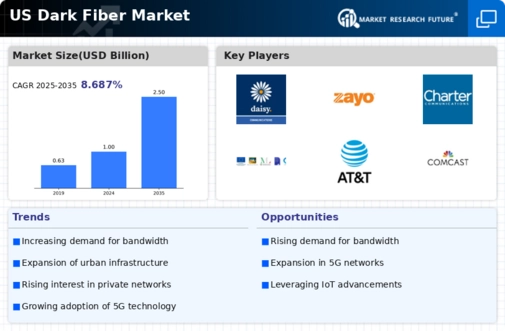Growing Need for Bandwidth
The dark fiber market is experiencing a notable surge in demand driven by the increasing need for bandwidth among businesses and consumers. As data consumption continues to rise, organizations are seeking solutions that can accommodate their growing requirements. This trend is particularly evident in sectors such as telecommunications and data centers, where the need for high-capacity networks is paramount. According to recent estimates, the bandwidth demand is projected to grow at a CAGR of approximately 25% over the next five years. This growth is likely to propel investments in dark fiber infrastructure, as companies look to enhance their network capabilities. Consequently, the dark fiber market is positioned to benefit from this escalating demand, as it offers scalable and flexible solutions that can meet the evolving needs of various industries.
Rising Demand for Data Centers
The rising demand for data centers is a crucial driver for the dark fiber market. As businesses increasingly rely on cloud computing and data storage solutions, the need for robust data center infrastructure has intensified. This trend is particularly evident in urban areas, where the proliferation of data-driven applications necessitates high-capacity connectivity. According to industry forecasts, the number of data centers in the U.S. is expected to grow by over 20% in the next few years. This expansion is likely to create a corresponding demand for dark fiber, as data centers require reliable and high-speed connections to support their operations. The dark fiber market is well-positioned to capitalize on this trend, providing the necessary infrastructure to meet the connectivity needs of an expanding data center ecosystem.
Shift Towards Private Networks
The shift towards private networks is emerging as a significant driver for the dark fiber market. Organizations are increasingly recognizing the benefits of deploying private networks to enhance security, control, and performance. This trend is particularly pronounced in sectors such as finance, healthcare, and government, where data privacy and security are paramount. The dark fiber market offers a viable solution for these organizations, enabling them to establish dedicated networks that are insulated from public internet vulnerabilities. As more enterprises invest in private network solutions, the demand for dark fiber is likely to increase. Industry analysts suggest that the market for private networks could grow by over 30% in the coming years, further bolstering the dark fiber market as organizations seek to leverage its advantages.
Technological Advancements in Fiber Optics
Technological advancements in fiber optics are playing a pivotal role in shaping the dark fiber market. Innovations such as wavelength division multiplexing (WDM) and improved fiber materials are enhancing the capacity and efficiency of fiber optic networks. These advancements enable service providers to offer higher bandwidth and faster data transmission rates, which are essential for meeting the demands of modern applications. As technology continues to evolve, the dark fiber market is likely to benefit from increased adoption of these advanced solutions. Furthermore, the integration of artificial intelligence and machine learning in network management is expected to optimize performance and reduce operational costs. This technological evolution may lead to a more competitive landscape in the dark fiber market, as providers strive to offer cutting-edge solutions to their customers.
Increased Investment in Telecommunications Infrastructure
Investment in telecommunications infrastructure is a critical driver for the dark fiber market. As the U.S. government and private sector entities allocate substantial funds towards enhancing network capabilities, the demand for dark fiber is expected to rise. Recent reports indicate that the U.S. telecommunications sector is projected to invest over $100 billion in infrastructure improvements by 2026. This investment is likely to focus on expanding fiber optic networks, which are essential for supporting high-speed internet and advanced communication services. The dark fiber market stands to gain from this trend, as it provides the necessary backbone for these infrastructure enhancements. As more companies and municipalities seek to upgrade their networks, the dark fiber market is poised for significant growth, driven by the need for robust and reliable connectivity.





















Leave a Comment